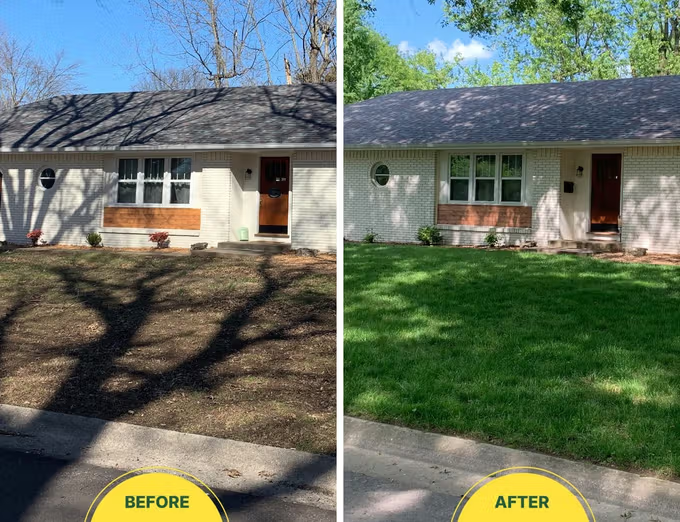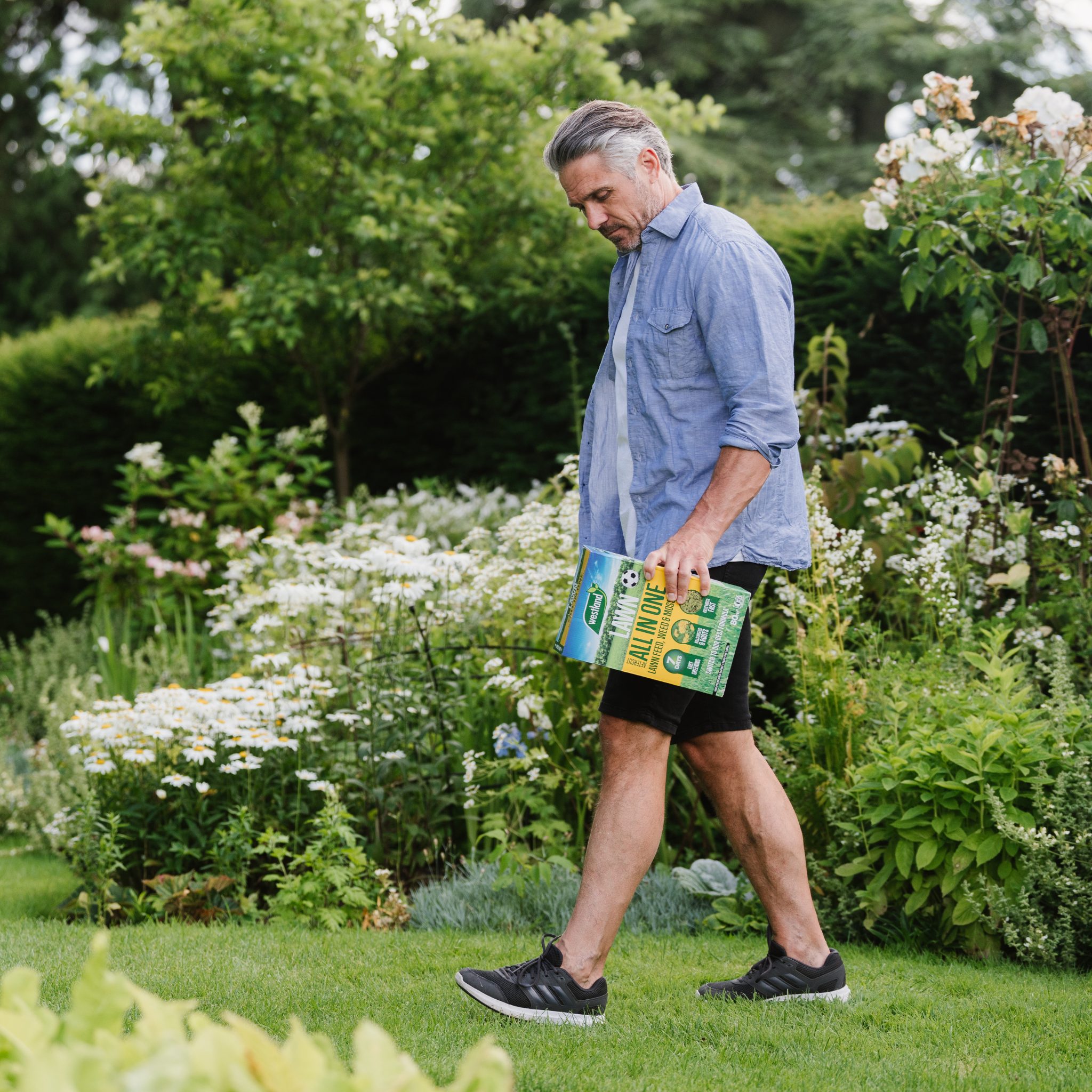Can You Put Too Much Lime On Your Lawn?
Last Updated on June 1, 2022 by Duncan
Lime application is critical to a beautiful, green, and thriving lawn. Lime ensures that your lawn has an adequate supply of calcium and your soil has a balanced pH.
Most lawns are packed with hydrogen and potassium, which are acidic, making the soil on your lawn acidic.
Lime naturally breaks down the soil, triggering the rise of calcium in the soil particles, which replaces the acidic components.
Applying the right amounts of lime to the soil is important, unfortunately, some people overdo it, either because they don’t know the right amount to apply or want to get splendid results.
Can you put too much lime on your lawn? Yes, you can do it if you aren’t keen on the application. Too much lime is bad for your lawn as it increases the soil pH, and when your soil is highly alkaline, your lawn experiences iron deficiency, and as a result, your grass turns yellow. Too much lime also increases the calcium levels in the soil, preventing the lawn from absorbing magnesium.
How much lime should I add to my lawn?
The amount of lime you add to your soil depends on two main things: your soil pH and the type of soil on your lawn.
This means that the first thing to do is undertake a soil pH. Most grasses thrive within a pH range of 5.8 and 7.0.
The ideal pH spot depends on the type of grass that you grow. If you have warm weather grass, you need your lawn to have a slightly lower pH, but your lawn will thrive at a slightly higher pH for cool weather grass.
You can hire a professional to test your soil pH or buy a pH kit such as this and test the pH by yourself. To be safe, Clemson University recommends you add lime if your pH is below 5.5.
The standard rule is to add 5 pounds of lime per 100 square feet in lawns with low pH, but you shouldn’t follow this rule as the amount varies depending on the type of soil you have in your yard.
To refresh your memory, there are three main types of soils: sandy, loam, and clay.
Sandy soil allows water and nutrients to move through it quickly. This means that lime will saturate the soil.
To tell whether you have sandy soil on your lawn, you should hold the soil in a ball. Sandy soil won’t form into a ball. Instead, it will fall apart.
Loam soil has a mixture of different particles of different sizes. The soil isn’t sandy. It isn’t too dense either—it’s in the middle.
Clay soil is dense hence, nutrients and lime take time to permeate. A tell-tale sign you have clay in your lawn is if you can clump the soil into a ball, and it retains its shape.
You might be wondering how the soil type impacts soil application, right? Since sand allows nutrients and water to move through quickly, you need less lime to raise the soil pH.
On the other hand, since clay doesn’t allow the nutrients to flow through quickly, you need to apply more lime to make an impact.
How do I calculate how much lime I need?
To help you calculate the amount of lime you need, use the table below:
| Soil Type |
Pounds of Lime per 100 square ft (raise pH from 4.5 to 5.5) |
Pounds of Lime per 100 square ft (raise pH from 5.5 to 6.5) |
| Sand or Loamy Sand |
2.30 | 2.75 |
| Sandy Loam |
3.67 | 5.97 |
| Loam | 5.51 | 7.80 |
| Silt Loam |
6.89 | 9.18 |
| Clay Loam |
8.72 | 10.56 |
| Muck | 17.44 | 19.74 |
Table summarizing the amount of lime you need to raise your soil pH depending on soil type.
NB: The table doesn’t cover all the possible starting and desired pH values, so you may need to do some rough estimates.
For example, to raise the pH of sandy loam, you need to add between 3.67 and 5.97pounds of lime per 100 square feet.
To help you understand how to calculate the amount of lime you need for your lawn, we need to use an example.
Let’s say that your current soil pH is 5.5 (you need to add lime), and you want to raise it to 6.5. This means that you will be using the far-right column of the table above.
You also find out that your lawn has sandy loam soil, meaning you will use the table’s second row.
You have a 30-foot by 20-foot lawn, so the total area of the yard is 30 feet X 20 feet = 600 feet. This means that you have six 100 square feet areas.
From the table above, you need to use 5.97 pounds of lime per 100 square feet to raise your clay soil pH from 5.5 to 6.5.
To get the amount of lime you need to raise your soil pH, multiply the number of 100 square feet areas in your lawn by 5.97. In our case, we should multiply 6 by 5.97 (6*2.75 = 35.8 pounds).
You should spread 35.8 pounds of lime evenly throughout your lawn.
What is the best way to spread lime?
The best way to spread your lime is to use a spreader. This is a wheeled basin that distributes lime as you push it forward. There are two main types of spreaders: drop and broadcast (rotary) spreaders.
Drop spreaders drop the lime straight down through holes in the bottom of the basin, while broadcast spreaders use a unique mechanism that flips the lime to a broader circle.
For the best outcome, apply half the recommended lime amount by walking back and forth horizontally with the spreader then, once the amount gets exhausted, add the second half by walking vertically.
While there are many spreader models in the market, the Scotts Elite Spreader is one of the best we have come across.
- Scotts Elite Spreader is advanced, accurate and engineered for a 20% faster application (vs. a standard 5 ft. spread pattern) to be used year-round
- Push spreader can be used for feed, seed, weed, salt and melt while providing the durability you need with the comfort you want
- The dual rotors provide exceptional accuracy while the ergonomic handle comes equipped with a smartphone holder
Last update on 2025-04-19 / Affiliate links / Images from Amazon Product Advertising API
Apply lime to a dry, healthy lawn. Don’t apply lime to a wet lawn as the lime will stick to the wet grass blades, which could lead to blade damage.
You shouldn’t add lime to a dormant or stressed lawn, as the lime will cause further damage to the grass.
When it comes to the best time to add lime to your lawn, you should do it in winter or fall. Since you add lime during the colder months, you give it time to work on your soil and change the soil pH before the roots become active in the spring.
Can I spread lime by hand?
You should never spread lime by hand. You don’t achieve an even distribution, so you over lime some areas and under lime others.
Spreading lime by hand is also unsafe as there is the risk of your unprotected skin getting irritated or even burning upon coming into contact with lime in the presence of moisture.
Even with the gloves on, don’t spread lime, as the practice is ineffective. The best way to go about it is to use a spreader.
Can You Apply Lime And Fertilizer At The Same Time?
While lime and fertilizer are growth supplements, they have different roles. The fertilizer feeds nutrients for the grass to thrive, while lime reduces the level of acid in the soil, making the nutrients easier to absorb.
Does this mean there is no harm in applying both simultaneously? Well, it’s highly discouraged to apply both simultaneously as you don’t know what your lawn needs.
The best way to go about it is first to undertake a soil pH test. If you do the test and find out that the pH is too high, it means that your lawn won’t get the maximum benefits of the fertilizer, so it’s wise to lime your lawn first to prevent a buildup of nitrates that can further increase the acid levels in the soil.
You should only consider adding fertilizer after balancing the soil pH, as you are sure that your grass will absorb the necessary nutrients.
Which is better, lime pellets or powder?
Lime pellets or granular lime are the most popular lime as it’s often easy to spread evenly as they work perfectly with spreaders.
Powder lime is not as popular, and it’s often difficult to evenly spread it as it’s a powder. Most people do it by hand, which we have said you shouldn’t do due to its risk and ineffectiveness.
While there are some spreaders that you can use to spread powder lime, they aren’t as efficient and effective as pellet spreaders.
So, which is better. Pellet or powder lime?
Go for pellet or granular lime, as it’s easy to spread it throughout your lawn evenly.
Besides powder and granular lime, there is also liquid lime that is easy to apply, as all you need to do is put it in the sprayer and spray your lawn.
The downside to liquid lime is that it’s easy to go overboard as it’s hard to judge how much you have applied in a given area, so you end up over or under liming certain areas.
Parting shot
It’s possible to put too much lime on your lawn and damage it. Thankfully, by using the right lime, and spreader and being keen in your application, you will easily avoid making this mistake.
If you aren’t sure about the right amount of lime to apply in a given area, get the input of a professional.
Also Read:



